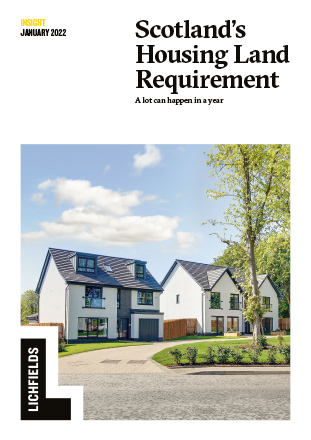Report highlights future need for housing land in Scotland
A new report identifying the need for greater balance in the type of land available for housing in Scotland, has been published by planning and development consultancy, Lichfields.
Gordon Thomson
The ‘Scotland’s Housing Land Requirement: A lot can happen in a year’ Insight report comes in the wake of National Planning Framework 4 (NPF4) being published for consultation in November 2021. This marks a critical stage in the ongoing reform to the country’s planning system and signals a step change in how local authorities in Scotland plan to meet the chronic need and demand for new homes in the coming years.
A key change sees the removal of the requirement by authorities to maintain a minimum five-year supply of effective land for housing at all times and move to looking at a 10-year supply across the planning spectrum.
Lichfields’ report highlights that this is the third significant shift in Scotland’s housing policy in under 12 months, which has been driven by a combination of national planning advice, court judgements and the upcoming national level development plan document.
A minimum of 200,000 new homes are identified as needing to be built in Scotland over the next 10 years to meet the minimum housing requirement set out by the Scottish Government and address the nation’s chronic housing shortage. This is 20,000 per annum significantly short of the 25,000 new homes per year target agreed to by each of the major parties at the last Scottish Election. It is therefore unclear how such a low target will address the housing crisis currently raging. It is also less than the current combined targets set in the Local Development Plans that currently guide development in Scotland (c.25,000 per annum).
Lichfields, which complied its report using housing land supply data from 28 local authorities across Scotland, says the next few months will be ‘tumultuous’ as NPF4 comes into effect.
However, until then, the debate rages on between the average and residual methods of calculating a five-year housing land. The difference between the two is clear, with Lichfields finding 26 authorities boosting their performance against the requirement to maintain an effective land supply when the average method is utilised; eight of which move from shortfall into surplus.

Gordon Thomson, planning director at Lichfields Edinburgh office and the report’s author, said it’s paramount that Scotland’s planning policy makers and housebuilders work together to ensure there is sufficient land available to meet the real housing need in Scotland, not just these minimum targets. This means identifying sufficient land that is deliverable and, in the locations where people want to live. Crucially there needs to be checks and balances in place to identify instances when targets will not be met and steps made to remedy any shortfall.
He added: “This is an important report coming at a time of significant change for planning in Scotland. Local authorities no longer need to demonstrate how they intend to deliver housing land. This places the onus on relying heavily on developing older sites or continuing to roll them over for possible future use.
“So, as we move forward, addressing Scotland’s housing land requirement has to be more about finding balance, identifying the right type of land and in the right locations including, if appropriate, new short-term land to meet any under-delivery.”
The report also identifies around 57,000 homes earmarked for development that will be wiped from the national housing land obligation across Scotland as NPF4 resets the requirement. “This must be seen as another setback to hopes for much needed residential development and the opportunity for more people to get on the housing ladder,” Gordon Thomson said.
It’s clear that housing land requirement reduction by local authorities, coupled with the removal of the need to maintain a continuous and demonstrably effective five-year supply of land, will have implications for housing construction, house prices and the types of homes built. These will be acute among those authorities that already have the minimum 10-year requirement programmed.
Constraining greenfield release might also have knock-on effects on the delivery of affordable housing. If market housing delivery and its associated affordable housing contributions reduces overall, and/or if the move to brownfield or constrained legacy sites squeeze affordable contributions as a result of viability, the Scottish Government might find it hard to deliver the affordable housing figures to which it is committed.
Gordon Thomson said: “Planning must reflect demand for housing - people will lose out if plans are not fulfilled. Can enough housing be delivered? Local authorities and developers can work together, but it’s about bringing forward a mix of land types in the right places. We will then be able to deliver the new housing and create the places where Scottish people will want to live and build communities.”

















